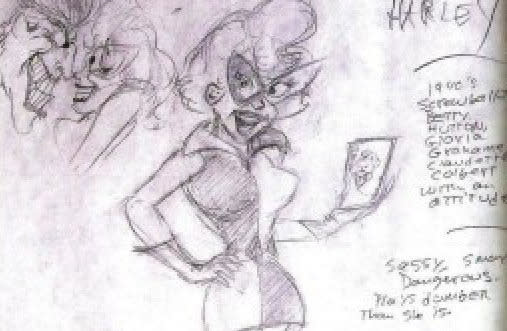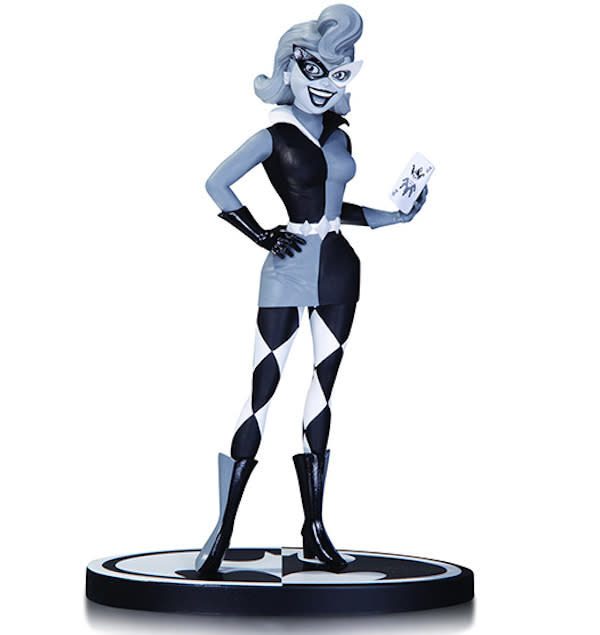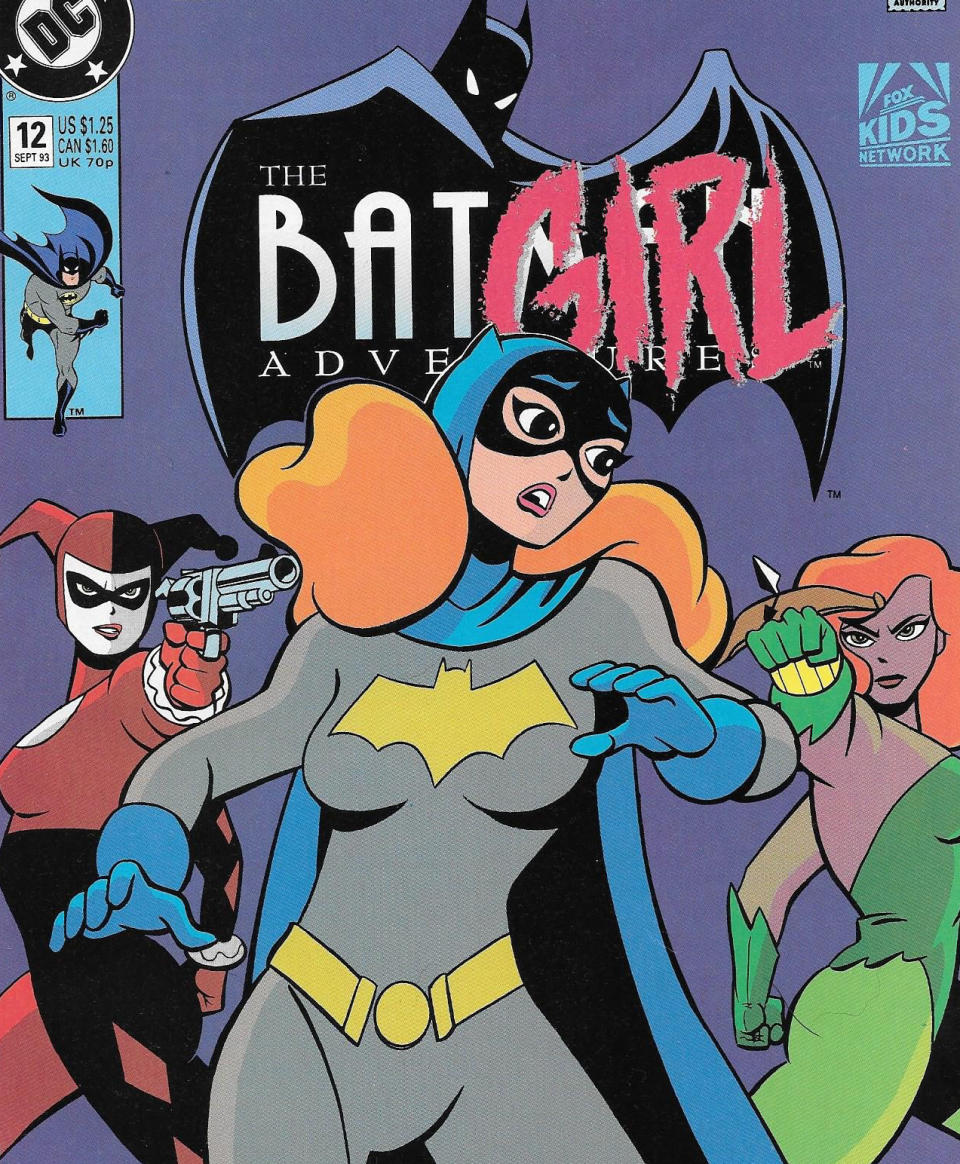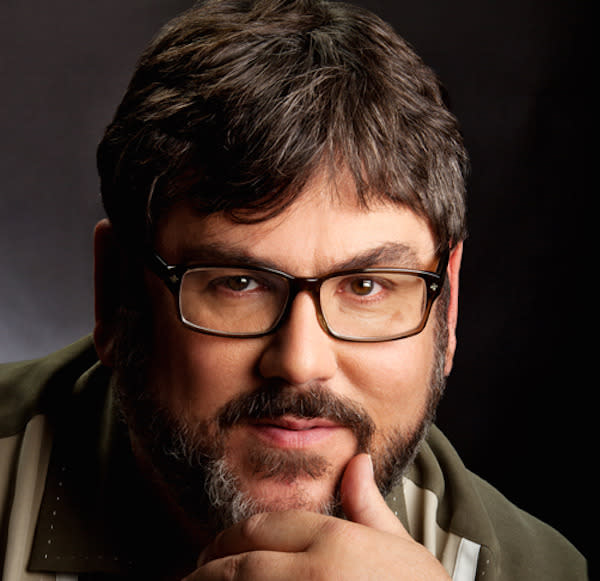A Soap Star, a Professor, and a Bombshell: The Strange But True History of Harley Quinn Revealed!

Margot Robbie as Harley Quinn in ‘Suicide Squad’ (Photo: Warner Bros.)
Harley Quinn is having a moment. Daddy’s Li’l Monster has emerged as an indisputable breakout in the run-up to the August premiere of Suicide Squad, perhaps the summer’s most anticipated film. Played on screen by Margot Robbie, the character is a relatively recent edition to the DC Universe, first surfacing in a 1992 episode of the classic cartoon Batman: The Animated Series. Over the years, she’s evolved into one of the major players of DC’s comics, fronting her own book and serving as a key member of the Suicide Squad. Not bad for someone conceived as a second banana to the Joker.
Related: Up Close and Personal With ‘Suicide Squad Costumes’
On the eve of Comic-Con, where the Squaddies are set to be out in full force ahead of the film’s Aug. 5 opening, we sat down with the man who dreamed up Harley Quinn and got a first-hand account of the strange origin of one of DC’s strangest characters.
________________________
In the early 1990s, Paul Dini was a writer for hire, cranking out scripts for the ground-breaking, noirish Batman: The Animated Series, when inspiration struck. For a story called “Joker’s Favor,” Episode 22 of the show’s first season airing on Sept. 8, 1992, a previously unseen character popped up in the background. She wore distinctive jester garb, cracked one-liners and earned the ire of the Clown Prince of Crime, with whom she had some unstated relationship. Harley Quinn was born. Dini picks up the story…
It was always understood that the Joker was going to have a rotating gang of hench-people, everybody from street thugs to circus-type people — whoever we needed at the moment. And for this one, I wanted to give him a female hench-person, because I felt it would fit the tone of what we were doing. It hearkened back to the Adam West series in the ’60s where you’d see the Riddler with Jill St. John or the Penguin with a young moll… and we thought it would be fun to do a modern-day twist on that.

Harley was a glorified background character in her first appearance in ‘Batman: The Animated Series’ (Clip: Warner Bros.)
I was looking for a name and thought “Harley” was a good one. I’m a big one on puns or names that describe what a character is — it’s something that goes back to Charles Dickens… I thought “Harlequin” was an interesting, fun kind of a character and I split up the name — Harley Quinn. It was cute.
The idea for the character came from several sources, and Dini envisioned her fitting a certain Hollywood trope.
I was working at home on some other projects and I had doodled up a drawing of this crazy blond character in a miniskirt. I based her on [I Dream of Jeannie star] Barbara Eden. A 1960s blonde in a miniskirt.

Dini’s original Harley Quinn sketch refers to her as a “1940s screwball, Betty Hutton, Gloria Grahame, Claudette Colbert with an attitude.” (Image: Paul Dini/Warner Bros.) DC later transformed his sketch into a statue (below).

I remember bringing it in to Bruce [Timm, the lead artist and co-producer on Batman: The Animated Series] and saying, “What do you thing of this?” And he looked at it and went, “Ooh. I think we can do better.” And he put my drawing aside and came up with something that was very sleek and very elegant; something I think he put a lot of heart and soul into. When I saw that first model, I said, “That’s perfect.” She combined a sense of fun and impishness. You could tell she was a gymnast or maybe a ballet dancer just from the way he drew her — up and ready to move.
Related: Decoding the ‘Suicide Squad’ Trailer
I saw Harley as a wise-cracking Girl Friday-type character that you might have seen in a ’30s or ’40s screwball comedy. I like the fact that she could crack a joke and the henchmen would laugh, and the Joker would kind of glare at her. It gave the scene a Punch and Judy quality of one-upmanship.
I also based her in part on my friend Arleen Sorkin — who wound up doing the voice — who has that personality of the very snappy, wisecracking, bubbly blonde. She was on TV a lot at that time, on Days of Our Lives and a show called Duet playing largely that character.

Arleen Sorkin, with her own Louisville Slugger, as Calliope on ‘Days of Our Lives’ (Photo: Joseph Del Valle/NBC/Getty Images)
So when I came up with Harley, I asked her, “Do you want to do the voice?” And she said, “Yes.” We brought her in — it was her first voiceover and she did a tremendous job on it.
Watch Sorkin on ‘Days of Our Lives’ in the character that helped inform Harley:
But I really didn’t have plans for the character beyond that episode.
Although she was intended as a one-off character, Dini couldn’t shake Harley. The rest of the Batman brain trust also became smitten with the burgeoning Maiden of Mischief and soon enough, she was back on the show.
There was something about the character. We thought she was a lot of fun. We didn’t want to do every Joker story with her in it, because we didn’t want to overuse her or make it just about the two of them — because the Joker has to be a credible threat when he’s on his own — but thought every couple of episodes, it wouldn’t be bad if she was part of the regular group.
Blessed with Sorkin’s squeaky, Brooklyn-accented pipes, Harley perfectly channeled Dini’s sense of humor. She also developed a few early catchphrases, including endearing nicknames for the Joker.
Every time I wrote her, I tried to think of funnier things for her to say to expand her role a little bit.
“Mr. J” was a natural because that made her a wisecracking blonde. “Puddin’” came from that lunch with Bruce, where he just said she should have a really goopy [nickname] for the Joker. And we both hit on it. “What about Puddin’?” “Oh, Puddin’ is great.”
As Harley became a key member of the animated series, DC took notice of her growing popularity and decided to transition the character to the comics. But she didn’t leap directly to the pages of the main DC Universe continuity; instead she appeared in a book based on the show.
There was an issue of The Batman Adventures, No. 12. And that was the first time she showed up in comics. … It was an all-girl story with [villain] Poison Ivy, Harley and Batgirl taking center stage. It was a way of using characters that had popped up in the animated series in a comic book.

Harley’s first comic book appearance (Image: DC Entertainment)
Working hand in hand with DC, they saw all the episodes first, and they were able to see all the scripts as they came in, and it was able to dovetail pretty closely to her teaming up with Poison Ivy in the animated series. They saw what we were doing with her and they liked it. She showed up in The Batman Adventures book first, and then Bruce and I came up with the “Mad Love” story. Then she began showing up more and more in the comic books.
“Mad Love,” a one-shot 1994 special issue of The Batman Adventures, established the origin story for Harley Quinn. For the first time, we learn that Dr. Harleen Quinzel was an intern at Arkham Asylum where she fell under the sway of the Joker and busted him out. She adopted the persona of Harley Quinn in an attempt to win his favor.
I’m no stranger to therapy. I was spending some time in therapy and was in my head a lot around that time. Bruce and I were discussing her origin one day over lunch, because I had been approached by DC to do a special issue of the comic, and we were talking about what if there was some sort of surprise to her origin? What if she’s not just a hench girl? We came up with the idea that she had been a doctor at Arkham Asylum and the Joker had gotten into her head and worked her into being his follower. … Then we thought, what if Harley’s in the role of the long-suffering girlfriend?

Harley’s origin story is revealed in ‘Mad Love’ comic (Photo: DC Entertainment)
There was also an element of the fans who write to a prisoner who committed a terrible crime and say, “I understand you… I see the good in you,” and sometimes develop a relationship.
It didn’t take much effort for Dini to come up with Harley’s real name.
Let’s think. Harley Quinn. OK, what’s easy? Arleen does her voice, we’ll put an H on the front. What’s [Arleen’s] middle name? Frances? We’ll use that. Harleen Frances. And then Quinzel. I knew there had to be a name that shortened to Quinn. I had a teacher at Emerson College named Quenzel — spelled slightly differently. Dr. Quinzel, or Professor Quinzel — I changed the spelling of the name, and I’m sure he’s not even aware of it. [We attempted to contact George Quenzel to find out if he had any inkling of his role in Harley’s origin, but the professor passed away in 2012.]
By the end of “Mad Love,” Harley is broken both physically and emotionally after being abandoned by the Joker. As she’s locked into her own cell at Arkham Asylum, she decides she’s through with her beloved Mr. J forever, only to find a flower and a note from him. It’s the start of a demented relationship.
She’s still into him. That growth is hard. For a person who’s really codependent or whose self-esteem is dictated by how they think other people think about them, they’ll take a crumb of affection and turn it into a whole cake. So Harley could swear off him and be very strong, but If there’s even the hint that he wants her back or he’s reformed, she’ll go back.

Joker and Dr. Quinzel meet cute in animated version of ‘Mad Love’ (Clip: Warner Bros.)
When I did the first comic book that placed her in canon in the Batman universe, she really has Joker at her mercy at one point. She’s going to send him to his death and she goes, “I’m gonna kill you, and I’m gonna make my life right again.” He’s hanging by his fingertips and he says something like, “Would it help if I said I’m sorry?” And she goes, “Yeah!” We play it for a laugh, but I wanted to share there’s some tragedy involved with making these choices. I think that had that continued with the character going along that way, she wouldn’t be as popular. I think at some point, she has to wise up and go, “This guy does me no damned good. I am a doctor after all and I do see what he’s doing. They’ll always be something in my head that feels something for this guy at some level, but I have to value myself more than he does.”
I also see the Joker as like Pygmalion. He never knew that he’d fall in love with his own creation. I think more than loving who Harley actually is, he loves what he turned her into. I think he viewed Dr. Harleen Quinzel an art project almost. “What can I make of this? I’m going to get her to break me out of the asylum, but am I going to bump her off? What am I going to do with her here?” And then she far exceeded his expectations to the point where he’s like, “Hey, wait a minute…” He actually did fall in love with elements that he brought out in her. But he’s still an abusive jerk.
Eventually, Harley did try to forge her own path in the cartoon and the comics, often paired with another Bat-villain, Poison Ivy.
We had also established Poison Ivy as a character on her own, and I thought, “What if she and Poison Ivy teamed up — it might be a fun story, where a strong female character brings something strong out of somebody who’s not as strong.” And then we wound up with the two of them being friends. And that became its own dynamic. The more we used Harley and the more we used her in different roles, the more we discovered what a richer character she was; she just blossomed, in a very short time, to the point where she was just as interesting as Catwoman or Penguin or Ra’s al Ghul or one of the other core Batman characters.
For a long time I thought, “What if we just did a Harley show? What if we just do her off on her own? Can I do a short with her where she’s just a manic presence?” At one point they were doing these DC Showcase Shorts … and I thought, “What about a solo Harley short that has no dialogue, it’s just her causing trouble to music? Almost like a weird Fantasia sequence where we show her as this crazy sprite. The idea never got further than that, but I kept pushing to make her a solo character independent of the Joker and Batman.
She started out as one thing and morphed into another. Mickey Mouse is not the same guy steering the steamboat and squeaking, and Bugs Bunny has gone from being a nameless rabbit to an iconic character. Same with Harley.
In 2009, Dini launched the Gotham City Sirens comic book, focusing on Harley, Ivy, and Catwoman. When that book ended its run in 2011, as DC was preparing to reboot its entire comics line, Dini’s clown princess faced an uncertain future.
I was afraid she might be in mothballs, but no. I was really excited when the New 52 came out, and she was so prominently featured. They did a solo book on her, and the Suicide Squad was going to use her. She was also such a prominent element in the video games. Suddenly she was everywhere.
And with anticipation for Suicide Squad at a fever pitch, Harley is about to go next-level…
About two years ago, I found out she was going to be in the movie. It was one of those things I just heard about. “Harley’s going to be in a movie.” Wow, that’s pretty cool. In talking casually with friends and peers, I said that someone should do a solo villain movie to really establish their presence in the DC Universe and show why they’re credible threats to the heroes. We know who Batman is. We know Superman. Now do a villain movie. When I heard they were doing Suicide Squad, introducing everybody except Lex, who was in [Batman v Superman: Dawn of Justice], I thought, “Good job.” It makes good sense to establish the key bad guys. And when I heard Harley was in the mix, I was going “Oh man, terrific.”
I’ve seen the trailer and some of the photos online. I love the color scheme. The candy-colored look. [Margot Robbie] looks great. Entertainment Weekly shows up on my door with the two of them on the cover [Robbie as Harley and Jared Leto as the Joker] and I think, “That’s so cool. That’s the live-action extension of the cartoon right there.” I have in my house the painting from her first comic book in the DC Universe… and she’s leaning back against the Joker. And I held up the cover [of Entertainment Weekly] next to it, and I said to myself, “15 years later, here’s what they’ve morphed into.” They’re still together and it’s still the iconic look.


Covers of Entertainment Weekly and Harley Quinn No. 1 (Photo: Entertainment Weekly; DC Entertainment)
_____________________
Paul Dini is an Emmy-winning writer whose most recent work, the graphic novel Dark Night: A True Batman Story, tells the harrowing tale of his brutal mugging and struggle to overcome his demons.

Paul Dini (Photo: Alan Weissman)
